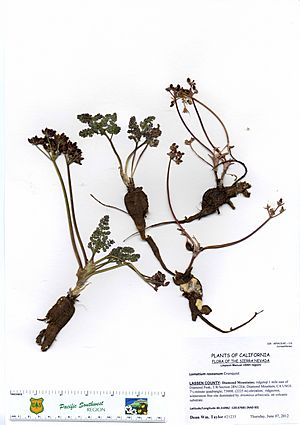Adobe lomatium facts for kids
Quick facts for kids Adobe lomatium |
|
|---|---|
 |
|
| Conservation status | |
| Scientific classification | |
| Kingdom: | |
| (unranked): | |
| (unranked): | |
| (unranked): | |
| Order: | |
| Family: | |
| Genus: | |
| Species: |
L. roseanum
|
| Binomial name | |
| Lomatium roseanum Cronquist 1992
|
|
| Synonyms | |
|
|
Adobe parsley (Lomatium roseanum) is a very rare plant found in the Western U.S. It is also known as adobe lomatium or rose-flowered desert-parsley. This plant grows mainly in northwestern Nevada and southeastern Oregon. It might also be found in northeastern California. The biggest groups of these plants live on the Sheldon National Wildlife Refuge. Adobe parsley is part of the celery family, called Umbelliferae. It has pretty yellow flowers.
Contents
What Does Adobe Parsley Look Like?
Adobe parsley is a plant that lives for many years. It usually grows taller than 10 centimeters (about 4 inches). This plant is smooth, without hairs, and has a stem that grows a bit from its base.
Roots and Leaves
It has a thick, potato-like root. Its leaves are green and shiny. They are divided into many small parts, each less than 1 centimeter long. The leaf stalks are wide and wrap around the main stem at the bottom.
Flowers and Fruit
The flower stalks grow upwards and are curved. They are about 15 to 20 centimeters (6-8 inches) long. Small, thin leaves, called bractlets, grow around the flower clusters. The flowers are yellow and turn whitish as they get older. The fruit has very narrow wings on its sides.
Where Does Adobe Parsley Live?
Adobe parsley is found in only a few places. It grows in Washoe County in Nevada. It is also found in nearby parts of southeastern Oregon. Sadly, it might have already disappeared from some of these Oregon areas. People also think it might exist in Humboldt County, Nevada. There are fewer than 20 known groups of these plants. However, some of these groups can be quite large.
Its Home Environment
Adobe parsley likes loose, rocky places. It especially prefers dry basalt talus scree, which are piles of broken rocks, on top of clay soils. It often grows near a type of plant community called low sagebrush. Other plants that grow with it include Poa secunda, Elymus elymoides, Arenaria aculeata, Phlox species, and Erigeron linearis.
Fire and the Plant
Scientists do not know much about how fire affects this type of plant. The low sagebrush areas where adobe parsley lives usually do not have enough fuel to start a big fire. If a fire does happen, the sagebrush plants are often killed. Then, other plants like medusahead and cheatgrass might grow there. The low sagebrush usually grows back from seeds in about 2 to 5 years.
Why Is Adobe Parsley Rare?
Adobe parsley is considered a sensitive or rare plant by several groups.
- The U.S. Forest Service in the Pacific Southwest Region lists it as a Sensitive Species. This means they are concerned about its future.
- The California Native Plant Society does not list it because it is not officially known to grow in California.
- The Nevada Natural Heritage Program calls it a Sensitive Plant in Nevada.
- NatureServe gives it a Nevada State Rank of S2S3. This means it is very rare or rare in Nevada. Its Global Rank is G2, meaning it is very rare worldwide.
How to Spot Adobe Parsley
You can find adobe parsley between 5750 feet (about 1750 meters) and 6175 feet (about 1880 meters) above sea level. The best time to spot it is in early spring, from April to June, when it flowers. It stands out because of its thick, potato-like root, yellow flowers, and shiny green leaves. It looks a bit like L. hendersonii, which is found farther north. However, adobe parsley is usually bigger and has a more noticeable stem at its base.
Images for kids



